Soil Moisture-Boundary Layer Feedbacks on the Loess Plateau in China Using Radiosonde Data with 1-D Atmospheric Boundary Layer Model
Abstract
:1. Introduction
2. One-Dimensional Model and CTP-HIlow Framework
2.1. One-Dimensional Model
2.2. CTP-HIlow Framework
3. Data and Methods
3.1. Modifications of the One-Dimensional Model
3.2. Data
3.3. Data Processing Methods
- -
- no rain or heavy cloud at the sounding time;
- -
- no super-adiabatic surface layer present in the sounding;
- -
- more than 20 vertical levels in the lower 400 hPa of the sounding.
4. Model Verification
5. Results
5.1. Soil Moisture-Atmosphere Feedbacks on the Loess Plateau
5.2. Distributions of Maximal Boundary Layer Height in Wet and Dry Soils
5.3. Atmosphere Background Influences on the Outcomes
5.4. Positive and Negative Feedback Distributions in Climate Scales
6. Discussion and Conclusions
- (1)
- We concluded the new CTP-HIlow thresholds in the Loess Plateau based on the modified slab model. For atmosphere-controlled cases: when HIlow < 10 °C, CTP < 100 J/kg, shallow clouds occur over both soil conditions; when HIlow < 10 °C, CTP > 100 J/kg, rain occurs over both soil conditions; and when HIlow > 26 °C, any CTP, no convection occurs over either soil condition. For soil moisture-controlled cases: when 10 °C < HIlow < 16 °C, CTP < 100 J/kg, shallow clouds occur over wet soils; 10 °C < HIlow < 16 °C, 100 < CTP < 240 J/kg, there is a wet soil advantage, i.e., rain or shallow clouds over wet soils only; when 16 °C < HIlow < 26 °C, 100 < CTP < 240 J/kg, there is a transition zone, and any outcome is possible; and when 16 °C < HIlow < 26 °C, 240 < CTP < 400 J/kg, there is a dry soil advantage, i.e., rain or shallow clouds over dry soils only.
- (2)
- The probability distributions of atmosphere-controlled cases and soil moisture-controlled cases of model outcomes were 69.83% and 30.17%, respectively. The probability distributions of the wet soil advantage cases and dry soil advantage cases of model outcomes showed some difference from the new CTP-HIlow diagnostic results. For model outcomes, it seemed like stations ZBHH, Jinghe, ZBYN, and ZLYA had more negative feedbacks, and the total percentage indicated that more negative feedbacks existed in the Loess Plateau. For new CTP-HIlow diagnostic results, stations ZBHH, Yinchuan, and Yuzhong present much more negative feedbacks; and stations ZBYN, Jinghe and Pingliang present much more positive feedbacks. In total, negative feedback is predominant in the northern and western portion of the Loess Plateau; in the southern and eastern portion, positive feedback is predominant.
Author Contributions
Funding
Acknowledgments
Conflicts of Interest
References
- Seneviratne, S.I.; Corti, T.; Davin, E.L.; Hirschi, M.; Jaeger, E.B.; Lehner, I.; Orlowsky, B.; Teuling, A.J. Invetigating soil moisture climate interactions in a changing climate: A review. Earth-Sci. Rev. 2010, 99, 125–161. [Google Scholar] [CrossRef]
- Santanello, J.A.; Dirmeyer, P.A.; Ferguson, C.R.; Findell, K.L.; Tawfik, A.B.; Berg, A.; Ek, M.; Gentine, P.; Guillod, B.P.; van Heerwaarden, C.; et al. Land—Atmosphere interactions in the LoCo perspective. Bull. Am. Meteorol. Soc. 2018, 99, 1253–1272. [Google Scholar] [CrossRef]
- Shuttleworth, W. The Modellion concept. Rev. Geophy. 1991, 29, 585–606. [Google Scholar] [CrossRef]
- Brubaker, K.L.; Entekhabi, D. Analysis of feedback mechanisms in land-atmosphere Interaction. Water Resour. Res. 1996, 32, 1343–1357. [Google Scholar] [CrossRef]
- Findell, K.L.; Eltahir EA, B. An analysis of the soil moisture–rainfall feedback, based on direct observations from Illinois. Water Resour. Res. 1997, 33, 725–735. [Google Scholar] [CrossRef]
- Nicholson, S.E. Land surface processes and Sahel climate. Rev. Geophy. 2000, 38, 117–139. [Google Scholar] [CrossRef]
- Vereecken, H.; Huisman, J.A.; Bogena, H.; Vanderborght, J.; Vrugt, J.A.; Hopmans, J.W. On the value of soil moisture measurements in vadose zone hydrology: A review. Water Resour. Res. 2008, 44, W00D06. [Google Scholar] [CrossRef] [Green Version]
- Sanchez-Mejia, Z.M.; Papuga, S.A. Observations of a two-layer soil moisture influence on surface energy dynamics and planetary boundary layer characteristics in a semiarid shrubland. Water Resour. Res. 2014, 50, 306–317. [Google Scholar] [CrossRef]
- Li, K.; Zhang, J.; Wu, L. Assessment of soil moisture temperature feedbacks with the CCSM-WRF model system over east Asia. J. Geophys. Res.-Atmos. 2018, 123, 6822–6839. [Google Scholar] [CrossRef]
- Yuan, G.; Zhang, L.; Liang, J.; Cao, X.; Guo, Q.; Yang, Z. Impacts of initial soil moisture and vegetation on the diurnal temperature range in arid and semiarid regions in China. J. Geophys. Res.-Atmos. 2017, 122, 11568–11583. [Google Scholar] [CrossRef]
- Huang, J.; van den Dool, H.M.; Georgakakos, K.P. Analysis of model-calculated soil moisture over the United States (1931–1993) and applications to long-range temperature forecasts. J. Clim. 1996, 9, 1350–1362. [Google Scholar] [CrossRef] [Green Version]
- Bosilovich, M.G.; Chern, J. Simulation of water sources and precipitation recycling for the MacKenzie, Mississippi, and Amazon River basins. J. Hydrometeorol. 2006, 7, 312–329. [Google Scholar] [CrossRef] [Green Version]
- Clark, R.T.; Brown, S.J.; Murphy, J.M. Modeling northern hemisphere summer heat extreme changes and their uncertainties using a physics ensemble of climate sensitivity experiments. J. Clim. 2006, 19, 4418–4435. [Google Scholar] [CrossRef]
- Namias, J. The annual course of month-to-month persistence in climatic anomalies. Bull. Am. Meteorol. Soc. 1952, 33, 279–285. [Google Scholar] [CrossRef]
- Zaitchik, B.F.; Macalady, A.K.; Bonneau, L.R.; Smith, R.B. Europe’s 2003 heat wave: A satellite view of impacts and land-atmosphere feedbacks. Int. J. Climatol. 2006, 26, 743–769. [Google Scholar] [CrossRef]
- Welty, J.; Zeng, X. Does soil moisture affect warm season precipitation over the southern Great Plains? Geophys. Res. Lett. 2018, 45, 7866–7873. [Google Scholar] [CrossRef] [Green Version]
- Moon, H.; Guillod, B.P.; Gudmundsson, L.; Seneviratne, S.I. Soil moisture effects on afternoon precipitation occurrence in current climate models. Geophys. Res. Lett. 2019, 46, 1861–1869. [Google Scholar] [CrossRef] [Green Version]
- Dirmeyer, P.A. The hydrologic feedback pathway for land–climate coupling. J. Hydrometeorol. 2006, 7, 857–867. [Google Scholar] [CrossRef]
- Van der Ent, R.J.; Savenije, H.H.G.; Schaefli, B.; Steele-Dunne, S.C. Origin and fate of atmospheric moisture over continents: Origin and fate of atmospheric moisture. Water Resour. Res. 2010, 46, W09525. [Google Scholar] [CrossRef] [Green Version]
- Eltahir, A.B.; Bras, R.L. Precipitation recycling. Rev. Geophy. 1996, 34, 367–378. [Google Scholar] [CrossRef]
- Chen, L.; Dirmeyer, P.A. Impacts of land-use/land-cover change on afternoon precipitation over North America. J. Clim. 2017, 30, 2121–2140. [Google Scholar] [CrossRef]
- Tuinenburg, O.A.; Hutjes, R.W.A.; Jacobs, C.M.J.; Kabat, P. Diagnosis of local land–atmosphere feedbacks in India. J. Clim. 2011, 24, 251–266. [Google Scholar] [CrossRef] [Green Version]
- Charney, J.G. Dynamics of deserts and drought in the Sahel. Q. J. R. Meteorol. Soc. 1975, 101, 193–202. [Google Scholar] [CrossRef]
- Dirmeyer, P.A. Using a global soil wetness dataset to improve seasonal climate simulation. J. Clim. 2000, 13, 2900–2922. [Google Scholar] [CrossRef]
- Koster, R.D.; Sud, Y.C.; Guo, Z.; Dirmeyer, P.A.; Bonan, G.; Oleson, K.W.; Chan, E.; Verseghy, D.; Cox, P.; Davies, H.; et al. GLACE: The Global Land–Atmosphere Coupling Experiment. Part I: Overview. J. Hydrometeorol. 2006, 7, 590–610. [Google Scholar] [CrossRef]
- Guo, Z.; Dirmeyer, P.A.; Koster, R.D.; Sud, Y.C.; Bonan, G.; Oleson, K.W.; Chan, E.; Verseghy, D.; Cox, P.; Gordon, C.T.; et al. GLACE: The global land–atmosphere coupling experiment. Part II: Analysis. J. Hydrometeorol. 2006, 7, 611–625. [Google Scholar] [CrossRef]
- Chen, Y.; Wang, K.; Lin, Y.; Shi, W.; Song, Y.; He, X. Balancing green and grain trade. Nat. Geosci. 2015, 8, 739–741. [Google Scholar] [CrossRef]
- Findell, K.L. Atmospheric Controls on Soil Moisture Boundary Layer Interactions. Ph.D. Thesis, Massachusetts Institute of Technology, Cambridge, MA, USA, 2001; p. 172. [Google Scholar]
- Ferguson, C.R.; Wood, E.F. Observed land–atmosphere coupling from satellite remote sensing and reanalysis. J. Hydrometeorol. 2011, 12, 1221–1254. [Google Scholar] [CrossRef]
- Kim, C.P.; Entekhabi, D. Feedbacks in the land-surface and mixed-layer energy budgets. Bound. -Layer Meteorol. 1998, 88, 1–21. [Google Scholar] [CrossRef]
- Kim, C.P.; Entekhabi, D. Impact of soil heterogeneity in a mixed layer model of the planetary boundary layer. Hydrolog. Sci. J. 1998, 43, 633–658. [Google Scholar] [CrossRef] [Green Version]
- Findell, K.L.; Eltahir, E.A.B. Atmospheric controls on soil moisture–boundary layer interactions. Part I: Framework development. J. Hydrometeorol. 2003, 4, 552–569. [Google Scholar] [CrossRef]
- Battan, L.J. Radar Observations of the Atmosphere; University of Chicago Press: Chicago, IL, USA, 1973; p. 324. [Google Scholar]
- Showalter, A.K. A stability index for thunderstorm forcasting. Bull. Am. Meteorol. Soc. 1953, 34, 250–252. [Google Scholar] [CrossRef] [Green Version]
- Clapp, R.B.; Hornberger, G.M. Empirical equations for some soil hydraulic properties. Water Resour. Res. 1978, 14, 601–604. [Google Scholar] [CrossRef] [Green Version]
- Chen, X.; Yu, Y.; Chen, J.B.; Zhang, T.T.; Li, Z.C. Study of Estimation of Soil Heat Flux at a Wheat Field in Semi-Arid Area of Loess Plateau. Plateau Meteor. 2014, 33, 1514–1525. [Google Scholar]
- Wakefield, R.A.; Basara, J.B.; Furtado, J.C.; Illston, B.G.; Ferguson, C.R.; Klein, P.M. A Modified Framework for Quantifying Land-Atmosphere Covariability during Hydrometeorological and Soil Wetness Extremes in Oklahoma. J. Appl. Meteorol. Climatol. 2019, 58, 1465–1483. [Google Scholar] [CrossRef]
- Bhowmick, M. Impact of Soil Moisture Variability on Convective Rainfall Activity over the Indian Sub-Continent. Ph.D. Thesis, The University of Leeds, Leeds, UK, 2016; p. 135. [Google Scholar]



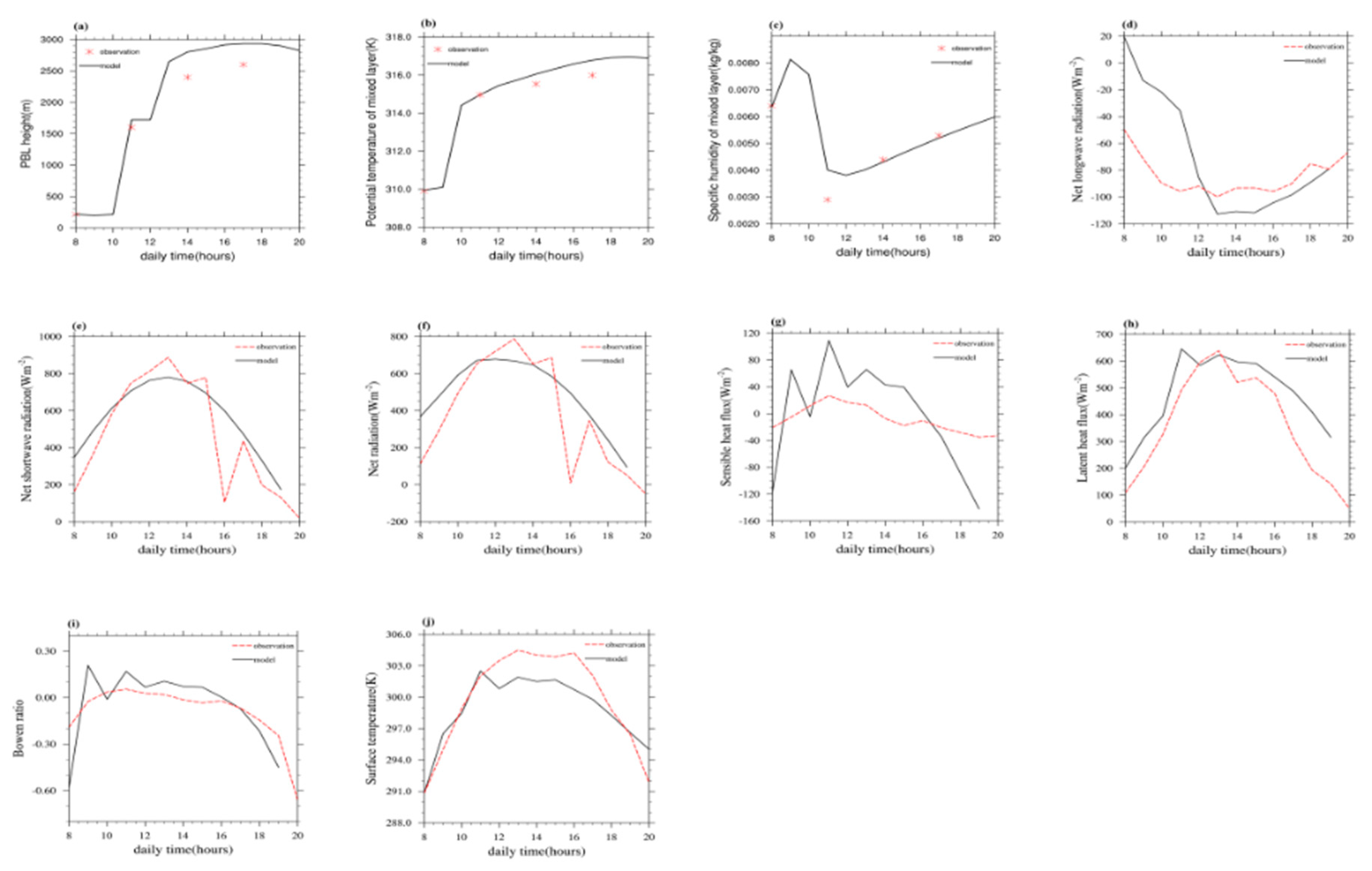
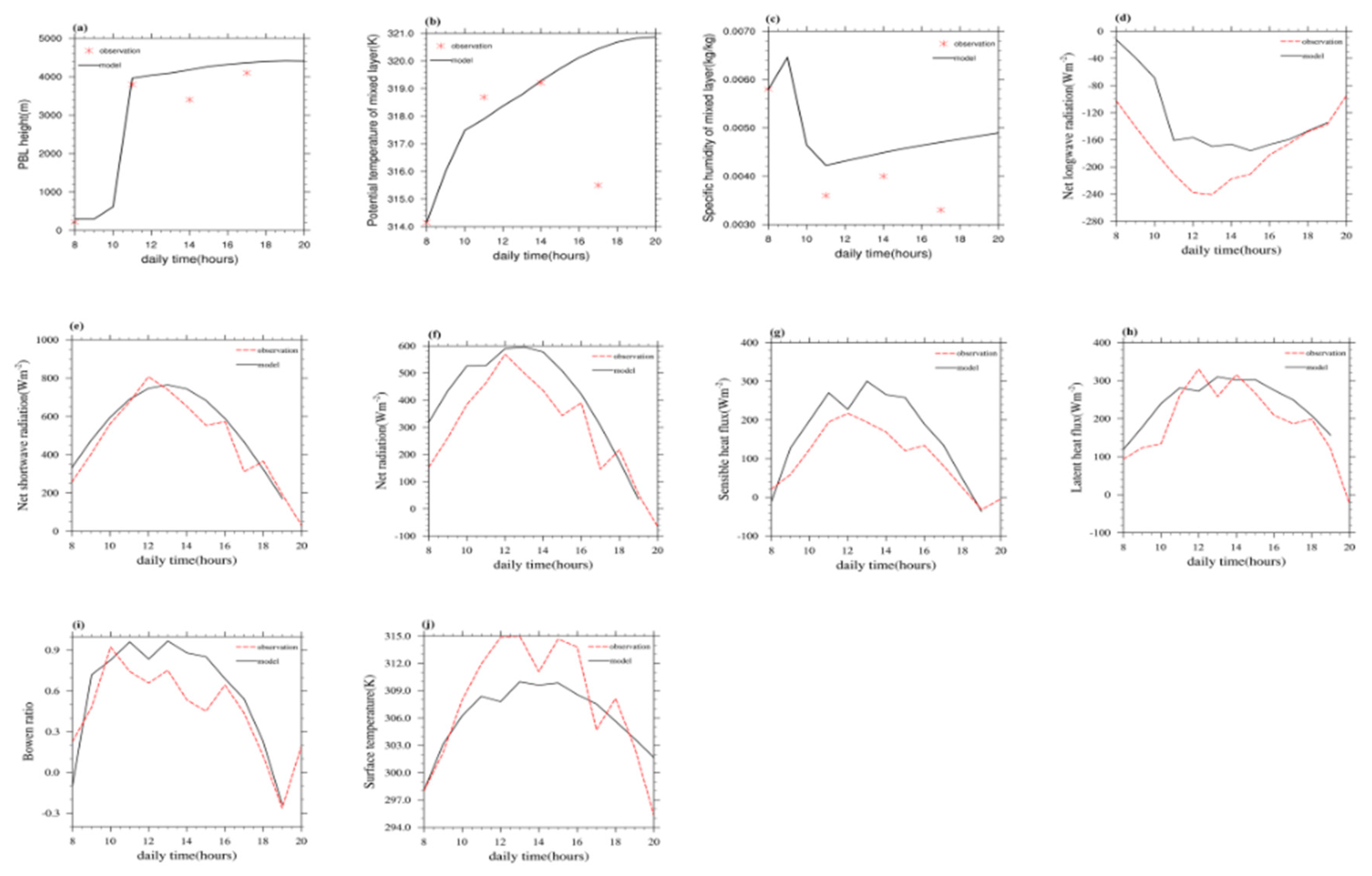

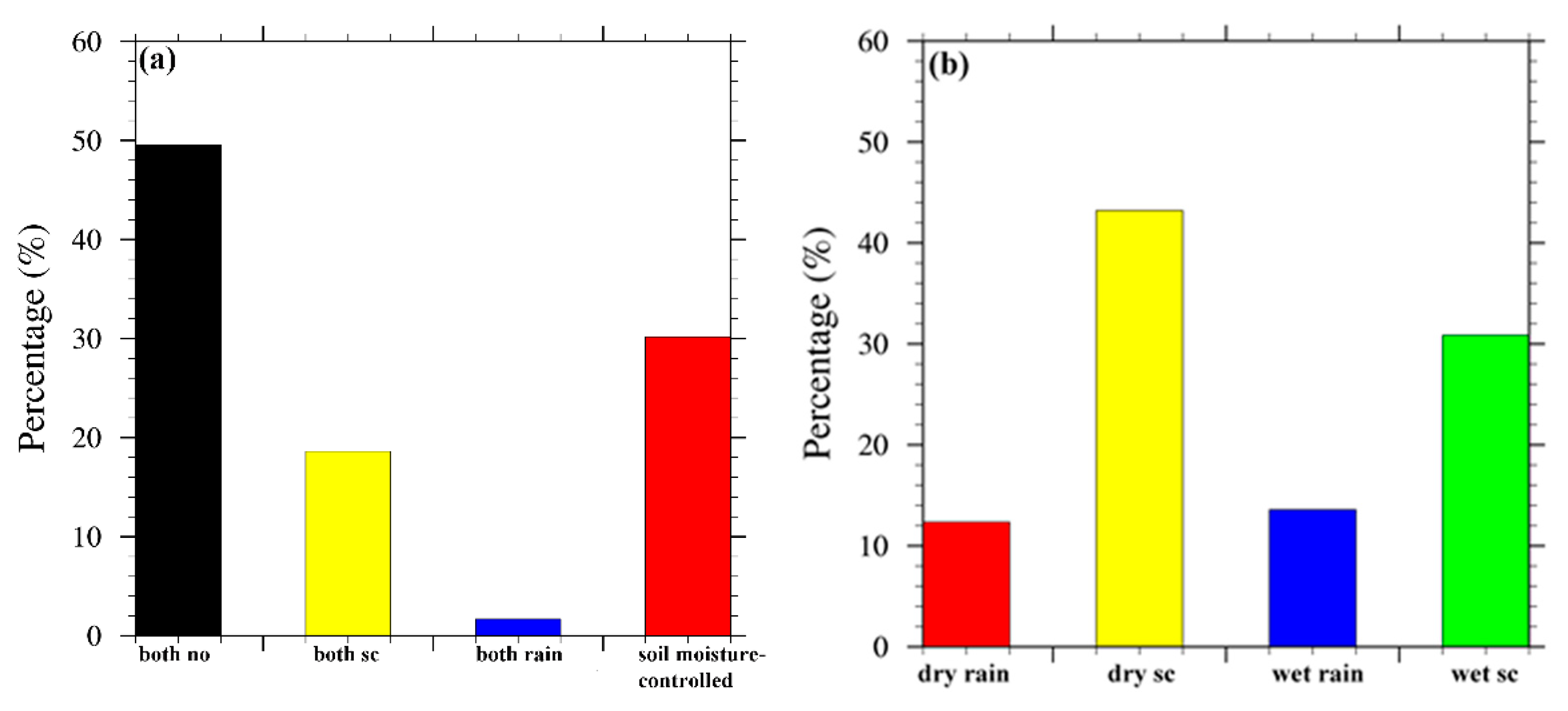
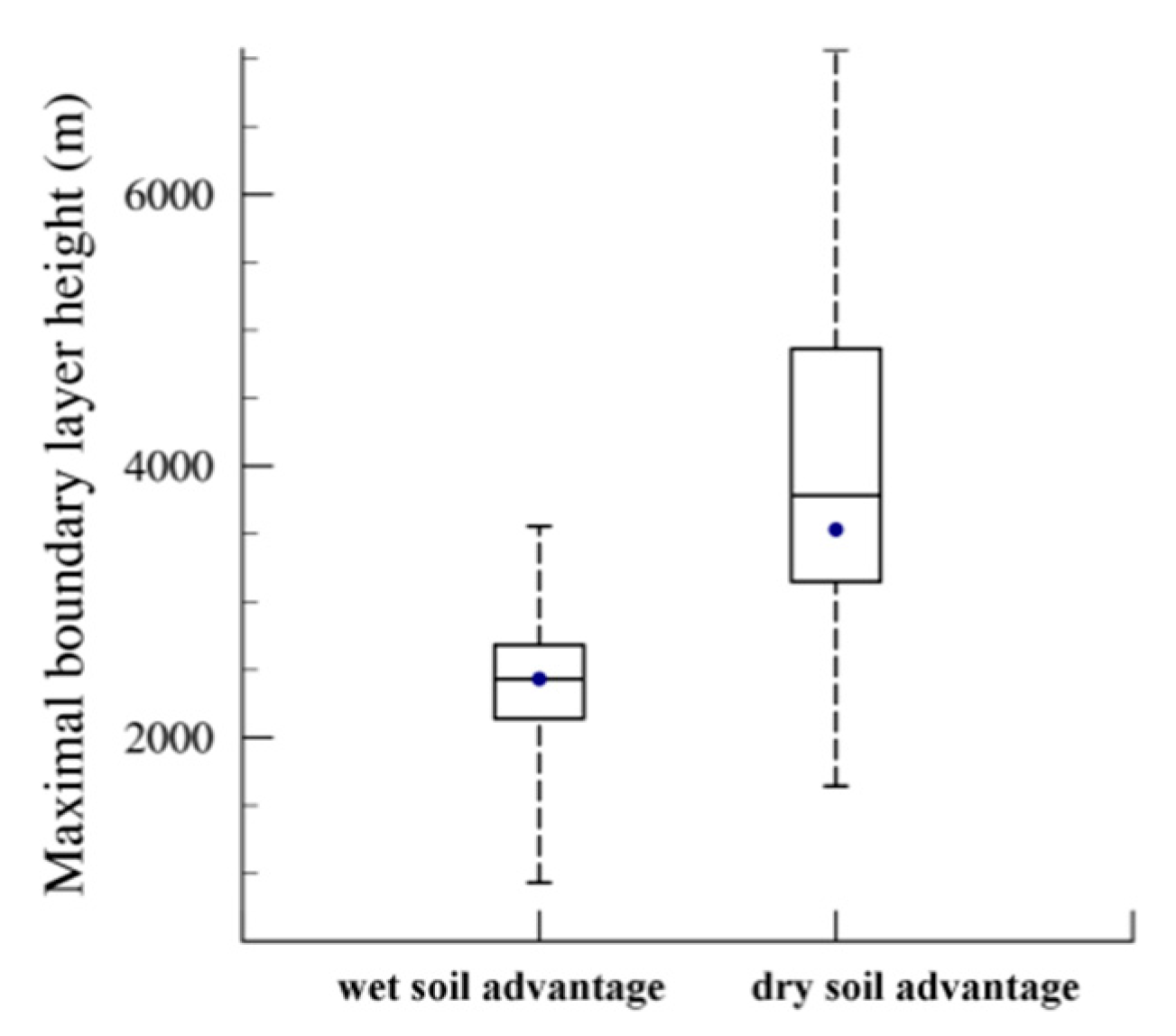

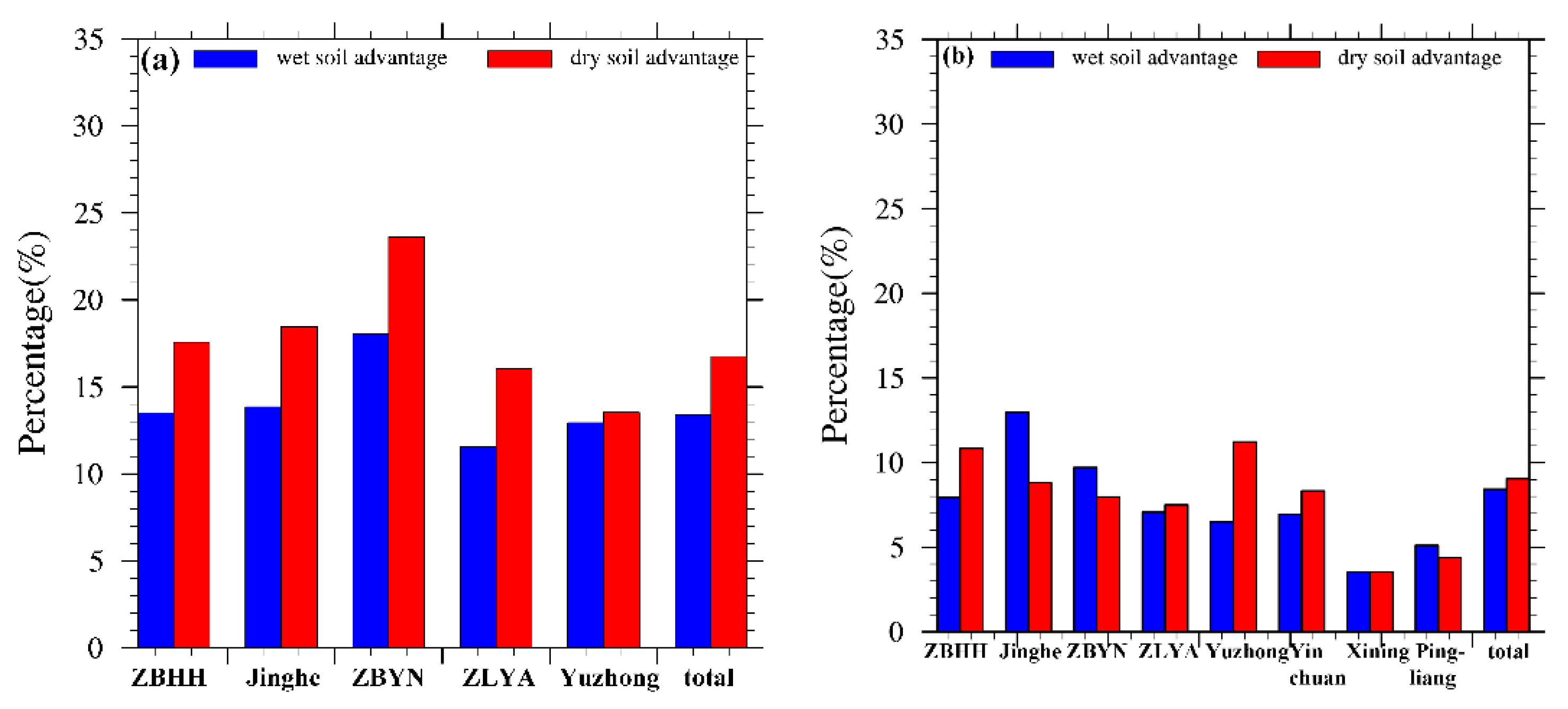
Publisher’s Note: MDPI stays neutral with regard to jurisdictional claims in published maps and institutional affiliations. |
© 2021 by the authors. Licensee MDPI, Basel, Switzerland. This article is an open access article distributed under the terms and conditions of the Creative Commons Attribution (CC BY) license (https://creativecommons.org/licenses/by/4.0/).
Share and Cite
Ma, Y.; Meng, X.; Ao, Y.; Yu, Y.; Li, G.; Lyu, S.; Li, J.; Xu, J. Soil Moisture-Boundary Layer Feedbacks on the Loess Plateau in China Using Radiosonde Data with 1-D Atmospheric Boundary Layer Model. Atmosphere 2021, 12, 1619. https://doi.org/10.3390/atmos12121619
Ma Y, Meng X, Ao Y, Yu Y, Li G, Lyu S, Li J, Xu J. Soil Moisture-Boundary Layer Feedbacks on the Loess Plateau in China Using Radiosonde Data with 1-D Atmospheric Boundary Layer Model. Atmosphere. 2021; 12(12):1619. https://doi.org/10.3390/atmos12121619
Chicago/Turabian StyleMa, Yingsai, Xianhong Meng, Yinhuan Ao, Ye Yu, Guangwei Li, Shihua Lyu, Jianglin Li, and Jie Xu. 2021. "Soil Moisture-Boundary Layer Feedbacks on the Loess Plateau in China Using Radiosonde Data with 1-D Atmospheric Boundary Layer Model" Atmosphere 12, no. 12: 1619. https://doi.org/10.3390/atmos12121619
APA StyleMa, Y., Meng, X., Ao, Y., Yu, Y., Li, G., Lyu, S., Li, J., & Xu, J. (2021). Soil Moisture-Boundary Layer Feedbacks on the Loess Plateau in China Using Radiosonde Data with 1-D Atmospheric Boundary Layer Model. Atmosphere, 12(12), 1619. https://doi.org/10.3390/atmos12121619





